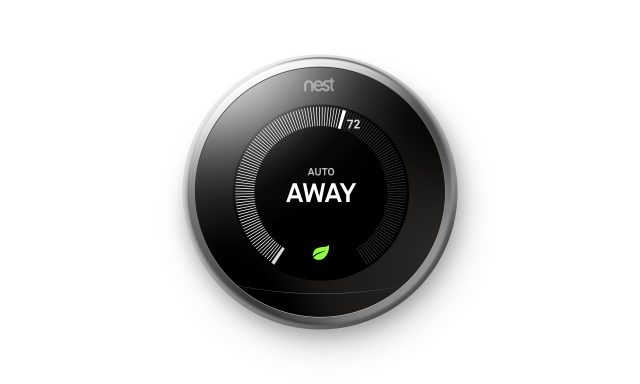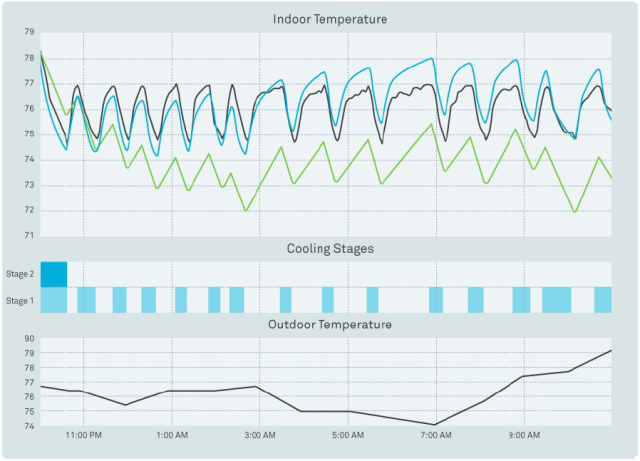
A thermostat can be such a simple device—so dumb a device if we’re feeling 21st Century snobby—that a strip of metal coiled up with a droplet of mercury at the end can do the job. The coil contracts as it cools, the mercury shifts to touch two wires and close a circuit, and on goes your furnace. Prefer a different temperature? Rotate the coil.
Simple is great, but that dumb device is responsible for a huge portion of your energy bill. That means constant adjustments are necessary if you want to avoid wasting energy overheating your house while you’re tucked into bed or away at work. This is the part of the story where the programmable thermostat walked in, offering automation in exchange for up-front fiddling. But a surprisingly large percentage of people with programmable thermostats don’t actually program them. In fact, the US EPA stopped offering “Energy Star” certification for programmable thermostats entirely in 2009 because their real-world impact was so unpredictable.
That's a problem, but the Nest Learning Thermostat has gained a following in the last few years by offering a solution—it programs itself as you turn it up or down throughout the week. The very same smarts that allow the device to program itself open other doors to efficiency as well. And at the company's Palo Alto offices, this seems to be just the beginning. Today, Nest is still working on its flagship device to make homes more energy-efficient.
Micro-management
Nest’s thermostat certainly wasn’t the first to enable scheduling for your furnace or air conditioner, nor is it the only thermostat that can connect to your Wi-Fi and offer advanced features. However, it does have a very different kind of scheduling interface. “We kind of took an engineering first principles approach and said, 'Well, geez, if as many as 80 or 90 percent of people with programmable thermostats aren’t programming at all or successfully, why don’t we just make the thermostat program itself?'" Nest Director of Energy Products Ben Bixby told Ars. "'Why don’t we take inconvenience, take things that we as fallible humans may not do optimally, and let’s leverage machine learning, let’s leverage some great sensors, and let’s optimize around that.'”
Helping you create a schedule accounts for the bulk of the thermostat’s impact on energy efficiency, but there are a number of smaller little tricks that can chip away at energy usage. The most visible one is probably a feature called “Auto-Away” that kicks the thermostat to its away temperature (which you choose) when the motion sensor detects that you aren’t around, whether because you left for vacation and forgot to turn down the heat or just left early for work. “The more you are away, and the more likely you are to forget to turn something down 100 percent of the time, each and every day you go off to work, depending on where you live, depending on what temperature you had it set at, [you save] maybe a dollar, maybe a couple dollars, and you multiply that out times hundreds of days per year for some people. For some people it means a lot of money, for some people it means less, but either way it’s generally appreciable,” Bixby said.
Beyond managing the temperature set point throughout the day, the thermostat applies some computing power to how your heating and cooling systems hit those set points. By tracking how temperatures change inside your home and accounting for weather conditions (which it receives from the Internet), it builds a mathematical model of your home over time. How quickly does the temperature rise as your furnace runs? How quickly does your home lose that heat? After a while, the Nest Thermostat can show you a pretty accurate estimate of how long it will take to reach a new temperature.

If you have a central air conditioner, you probably have two separate components—the fan that pulls the air from the air conditioner and the compressor that makes that air cold. Most thermostats just turn them on and off together, but the compressor (which is the energy hog between the two) doesn’t stop being cold the instant you turn it off. Nest’s thermostat learns how long it can continue to pull cool air without the compressor running. That eventually allows it to turn the compressor off a little early, coasting down to the temperature set point with just the fan. You shouldn’t feel a difference, but this avoids some wasted energy.
If a thermostat is going to micro-manage a system like that, it can’t be ignorant of what type of system it’s working with. If you have, say, a heat pump, the Nest thermostat will do things differently than it would with a gas furnace. Heat pumps generally have an auxiliary heat source that is much less efficient but works faster. You can tell your thermostat how patient and efficient you’re willing to be and, leaning on that mathematical thermal model of your home, it will manage how much auxiliary heat it uses. When avoiding the auxiliary, it knows how early it needs to kick on in order to reach the temperature you want by the time you wake up. You, on the other hand, can just do a Ron Popeil—set it and forget it.
reader comments
255